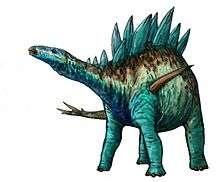Hungarosaurus
| Hungarosaurus Temporal range: Late Cretaceous, 85 Ma | |
|---|---|
 | |
| Right dentary | |
| Scientific classification | |
| Kingdom: | Animalia |
| Phylum: | Chordata |
| Class: | Reptilia |
| Clade: | Dinosauria |
| Order: | †Ornithischia |
| Family: | †Nodosauridae |
| Subfamily: | †Struthiosaurinae |
| Genus: | †Hungarosaurus Ősi, 2005 |
| Species: | †H. tormai |
| Binomial name | |
| Hungarosaurus tormai Ősi, 2005 | |
Hungarosaurus tormai (hungar = named for Hungary, Greek sauros = lizard, species named for András Torma; Ősi, 2005) is a nodosaurid ankylosaur from the Upper Cretaceous (Santonian) Csehbánya Formation of the Bakony Mountains of western Hungary. It is the most completely known ankylosaur from the Cretaceous of Europe. Cladistic analysis on the taxon indicates that it is a basal member of the Nodosauridae, more derived than Struthiosaurus (another European nodosaurid), yet still more primitive than North American forms such as Silvisaurus, Sauropelta, and Pawpawsaurus. The length of Hungarosaurus is estimated to have been about 4 meters. The skull of this dinosaur is estimated to have been 32-36 cm. in length. Like all nodosaurids, Hungarosaurus was herbivorous. Ankylosaur material has been known from Europe since the 19th century, with finds having been previously made in England, Austria, western Romania, France, and northern Spain.
Holotype
Four specimens of Hungarosaurus tormai are known, all collected from an open-pit bauxite mine near the village of Iharkút, Veszprém County, in the Bakony Mountains (Transdanubian Range) of western Hungary. The quarry exposes the Csehbánya Formation (which overlies the Halimba Formation, also Cretaceous in age), which is a floodplain and channel deposit consisting largely of sandy clays and sandstone beds. The specimen designated as the holotype is MTM Gyn/404 (in the collections of the Magyar Természettudományi Múzeum, Budapest, Hungary) and consists of 450 bones, including portions of the skull (premaxilla, left prefrontal, left lacrimal, right postorbital, jugal and quadratojugal, left frontal, pterygoid, vomer, the right quadrate and a fragment of the left quadrate, basioccipital, one hyoid), an incomplete right mandible, three cervical vertebrae, six dorsal vertebrae, ten caudal vertebrae, ossified tendon fragments, three cerival and thirteen dorsal ribs, five chevrons, the left scapulocoracoid, right scapula, portions of the right manus, a partial pelvis, and more than one hundred osteoderms.[1]
Associated fossil vertebrates
The exposure of the Csehbánya Formation that produced Hungarosaurus tormai has also yielded remains of bony fishes, turtles, lizards, crocodiles, and pterosaurs, along with teeth from a diminutive dromaeosaurid-like theropod and a Rhabodon-like ornithopod.[1]
See also
References
- 1 2 Ősi, Attila (2005). "Hungarosaurus tormai, a new ankylosaur (Dinosauria) from the Upper Cretaceous of Hungary." Journal of Vertebrate Paleontology 25(2):370-383.
External links
- Hungarosaurus (with pictures)
- Dinosaurier-Info (in German)
- Hungarian Dinosaur Expedition (mostly in Hungarian)

